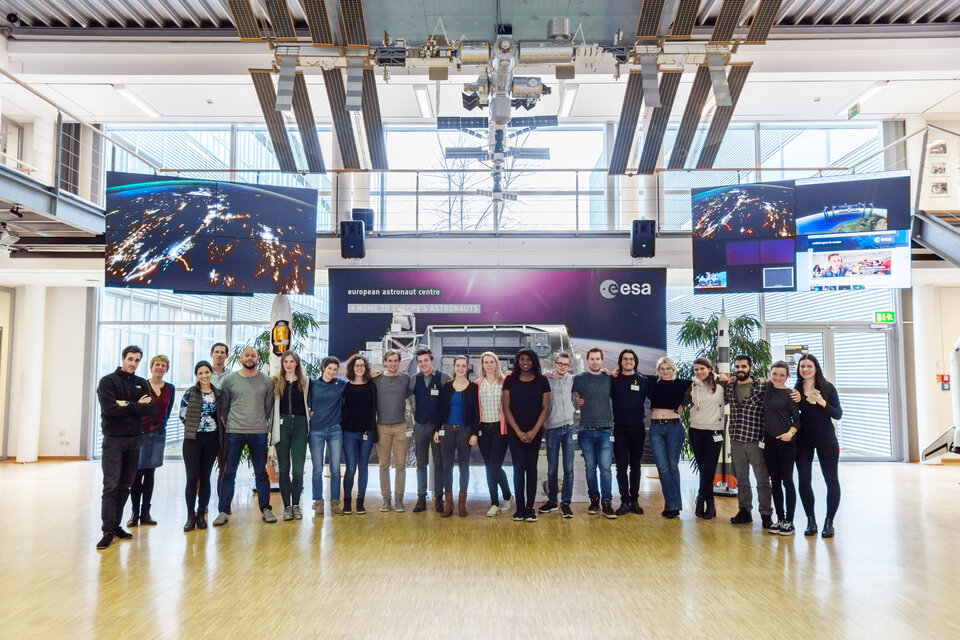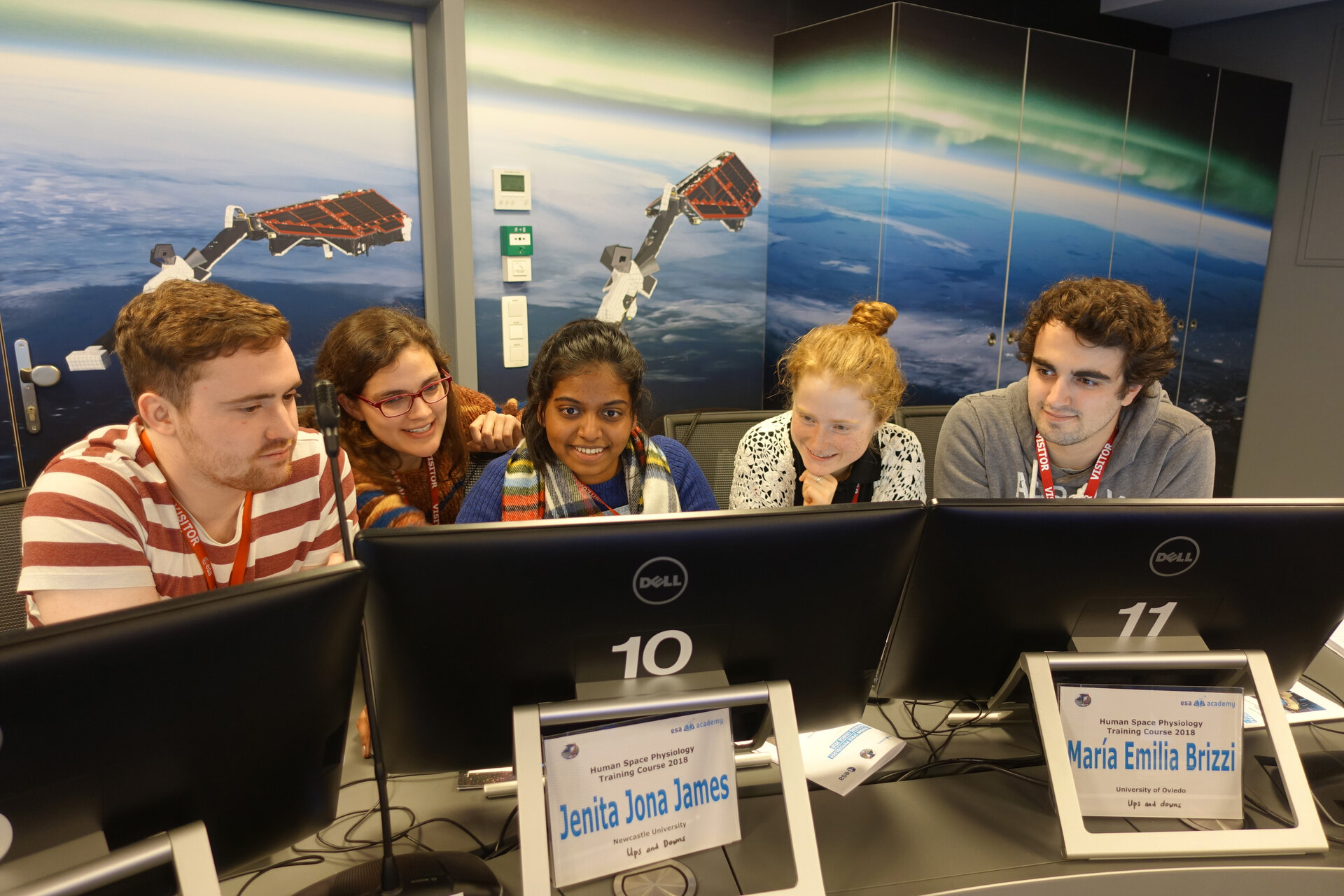Participate in ESA Academy’s human space physiology training course
What is it really like to live in space? What happens to the body in microgravity? Now, thanks to a training course being offered by ESA’s Education and Space Medicine Team, medical and life sciences university students can find out.
ESA’s Education Office and the Space Medicine Team are inviting BSc and MSc university students studying medicine, allied healthcare subjects, life, biomedical or biological sciences to apply to the Human Space Physiology training course 2019. The course will be held between 19 and 22 March 2019. Two groups of university students will be able to take part in this training course from two different ESA sites connected through videoconferencing. When selected, students will be invited to the ESA Academy’s Training and Learning Facility at ESA’s European Space Security and Education Centre (ESEC) in Belgium, or to the European Astronaut Centre (EAC) in Germany.
Through face-to-face and videoconference lectures delivered from each location, students will discover how spaceflight represents a significant physiological challenge to the human body. Having evolved in Earth’s gravity, our bodies adapt when in microgravity. Some of these adaptations may comprise astronaut health and wellbeing, either in flight or upon return to Earth. As a result, these adaptations must be understood in order to inform development of effective strategies to support humans during prolonged space missions.

During the four-day course, students will learn about life in space and the physiological adaptations associated with it, in addition to how a range of Earth-based analogues, such as long-term (head down) bed rest and over-wintering in Antarctica, are used to investigate some of the potential underlying mechanisms. Finally, current and some potential future approaches to mitigate the effects of weightlessness on the human body will be discussed.
As part of the programme, students will work on a mini-project addressing some of the major issues and challenges facing human spaceflight in groups of 5 or 6. Then on the final day, each group will present their findings to the other participants. Topics will include: Female flyers - how can/should female astronaut health be addressed?; Bouncing babies - what could the biological effect of being born in partial gravity (e.g. the Moon) be on human development?
Students participating in this training course can expect to be introduced to the following topics:
- What it’s really like to live in space
- The challenges, lessons, and successes that have led to permanent occupation of the International Space Station,
- The conditions that the ISS provides to protect and support life
- How the senses perceive being ‘weightless’
- How key physiological systems respond to microgravity, what mechanisms underlie these changes, and some approaches that may be used to mitigate such effects
- Human space physiology research is performed both in space, and using Earth-based analogues
- Major issues and challenges facing current human spaceflight and future space exploration.
Preliminary Schedule
| Day 1 |
Introduction The Space Environment – Outside and Inside a Space Vehicle History of Human Spaceflight Introduction to the Group Project Technology to Support Human Space Physiology Fundamentals of Baromedicine and Space Suits |
| Day 2 |
How Do Animal and Cellular Studies Help Our Understanding of Human Space Physiology ESA Ground Analogues The Vestibular System and Neuroplasticity Medical Support of ISS Astronauts What Do the Other Senses Make of Being in Space? Group Project |
| Day 3 |
The Cardiovascular System in Space Fundamentals of Musculoskeletal Physiology in Space Wound Healing in Space ESA & ESA Education Programme Space Radiation Immunology in Space Group Project |
| Day 4 |
Group Project Presentations Spaceflight Countermeasures and Medical Projects at the EAC The Personal Experience of Life in Space |

Interested students can fill in the application form here. The deadline for submission of completed applications is 14 January 2019 at 23:59pm CET.
Further information
Who can apply?
Students enrolled in university and who fulfil the following criteria at the time of application may be eligible:
- be aged between 18 and 32;
- be a citizen of an ESA Member States, Canada and Slovenia;
- be enrolled as a full-time BSc or MSc student (or equivalent) in a university for the year 2018-2019 (not graduating before the end of the training course);
- be studying medicine, allied healthcare subjects, life, biomedical or biological sciences.
The selected students will be sponsored by ESA’s Education Office and the Space Medicine Team. The sponsorship will cover accommodation and meals, as well as up to 200 euros for travelling to Transinne, Belgium or Cologne, Germany.
How do I apply?
- Fill in the application form;
- Upload a motivation letter (PDF, maximum 1 page, no images);
- Upload a CV (Europass format, PDF, maximum 2 pages);
- Upload a formal recommendation letter (PDF, maximum 1 page, including signature, no images) from a university professor or an academic supervisor from your current university;
- Upload an official copy of academic records (PDF, in English, with the university stamp);
- Upload a short abstract (maximum 500 words) based on the title "Being in space can induce physiological de-conditioning " Briefly define the major changes observed in a single physiological system (of your choice) and discuss whether this presents any issues for a mission to the Moon (PDF, no images);
All correspondence and documents should be in English (except academic records if not available).
For more information, please contact: esa.academy @ esa.int


